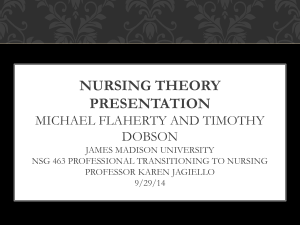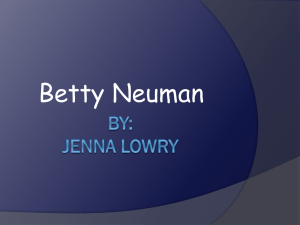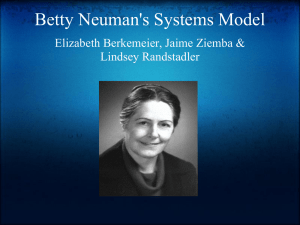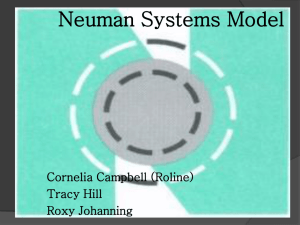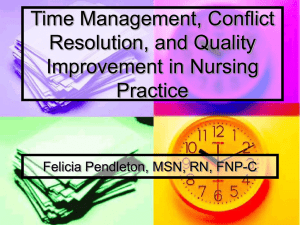Neuman Systems Model: Nursing Theory Overview
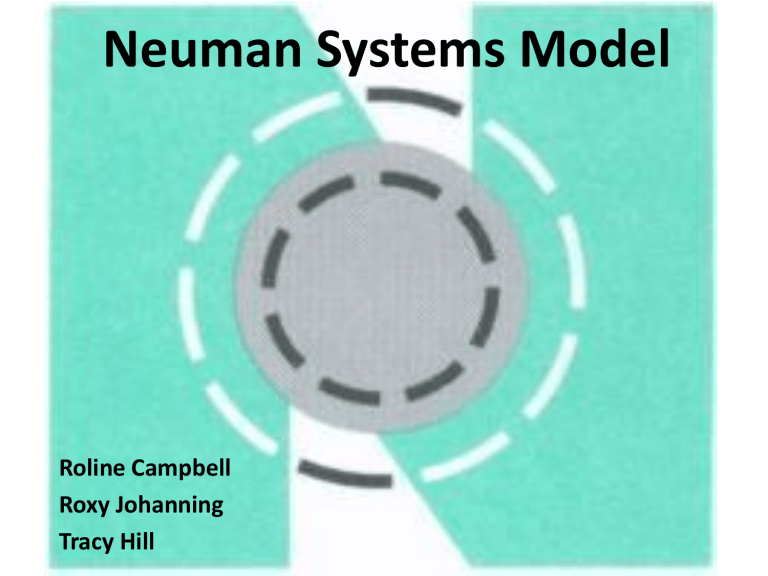
Neuman Systems Model
Roline Campbell
Roxy Johanning
Tracy Hill
Presentation Objectives:
1.
Introduce Betty Neuman
2.
Overview of the Neuman Systems Model (NSM) it’s concepts and principles
3.
Evaluate the NSM nursing theory using Fawcett’s criteria
4.
Compare the NSM with two other nursing theories
5.
Discuss and analyze the use of the NSM
Meet Betty Neuman
• Born in 1924 on a farm near Lowell, Ohio.
• Completed initial nursing education
• Then moved to Los Angeles
• Worked in a variety of nursing roles - always with an interest in human behavior.
• She attended UCLA
• 1957: Completed bachelor’s degree with a double major in Public Health & Psychology.
• Helped her husband to establish and manage his medical practice.
Career advances
•
1966: Master’s degree in Mental Health, Public Health
Consultation from UCLA.
• Pioneer of nursing involvement in mental health.
• Late 1960’s: Teaching and practice model for mental health consultation.
•
Requests from UCLA graduate students prompted the design of a conceptual model for nursing in 1970.
• First published in 1972 in an article entitled “A Model for
Teaching Total Person Approach to Patient Problems”
(Neuman & Young, 1972).
•
1974 – 2002: Further development and refinement of the
NSM. (First called “The Neuman Systems Model” in 1985 – retained the same title since then.)
• 1985: Doctoral degree in Clinical Psychology from PWU.
Recent years
•
•
Maintained involvement in variety of professional and international activities
•
Moved back to Watertown, Ohio and practiced as a licensed clinical marriage and family therapist.
•
Founder/Director of the Neuman Systems Model
Trustees Group, Inc.
Holds two Honorary Doctorates
• 1992: Honorary Doctorate of Letters (Neuman College)
• 1998: Honorary Doctorate of Science (Grand Valley State
University)
•
Fellow of the American Academy of Nursing (1993)
Betty Neuman as keynote speaker at the
University of Maine, Fort Kent in 2004
.
“It is important to state that neither was
I knowledgeable about nursing models nor had a clear trend yet begun in nursing for developing models. The Neuman
Systems Model was developed strictly as a teaching aid”
- Betty Neuman, 2002
An Overview of the
Neuman Systems Model
Philosophical Claims
o Wholism o
Wellness orientation o
Client perception and motivation o
Dynamic systems perspective of energy & variable interaction with the environment o
Client & caregiver in partnership
Key Concepts
Classified according to the applicable metaparadigm forerunner.
Human
Beings
• Client/Client
System
• Interacting
Variables
• Basic Structure
• Flexible line of
Defense
• Normal line of
Defense
• Lines of
Resistance
Environment
• Internal
Environment
• External
Environment
• Created
Environment
• Stressors
Health
• Health/Wellness/
Optimal Client
System Stability
• Variances from
Wellness
• Illness
• Reconstitution
Nursing
• Prevention as
Intervention
Client/Client System
o o o o
Viewed as open system
Repeated cycles of input, process, output & feedback
Thus a dynamic organizational pattern
Can be
• Individual
• Family
• Group
• Community
• Aggregate (Social Issue)
Interacting Variables
Developmental Spiritual
Present in
Socio-cultural
Physiological
Psychological each type of client
Consider these simultaneously & comprehensively
Central Core
Basic survival factors
Normal temp range
Genetic Structure
Response pattern
Organ strength/weakness
Ego structure
Flexible Line of Defense (FLD)
• Outer barrier
(protective buffer)
• Dynamic – can be altered in relatively short period of time
• Prevents stressor invasion of the client system
Normal Line of Defense (NLD)
Client’s normal wellness level
What client has become / evolved into over time
Defines the stability & integrity of client system
Standard from which to measure health deviation
Lines of Resistance
• Protective mechanism
• Attempts to stabilize the client system (support return to wellness)
• Supports the basic structure & normal line of defense
• Contains resource factors
Internal Environment
Forces & interactive influences confined within client system
Intrapersonal
Stressors
External Environment
Forces & interaction influences existing outside the client system
Created Environment
Symbolic expression of system wholeness
Unconscious mobilization of all system variables
Interpersonal
Wellness and Illness
•
•
Optimal Wellness
System stability
Greatest possible degree of system stability at a given point in time
•
•
•
Illness
State of insufficiency
Disrupting needs are unsatisfied
Excessive expenditure of energy
Variance from Wellness
• Varying degrees of system instability
• Difference from the normal or usual wellness condition.
Prevention as Intervention
o
Basis for health promotion o
Nursing is prevention as intervention o
Three dimensions
• Primary prevention
• Secondary prevention
• Tertiary prevention
Primary Prevention
o
Health promotion & Maintenance of wellness o
Occurs before the system reacts to a stressor o
Strengthens the client / client system to better deal with stressors (FLD) o
May also try to manipulate the environment to reduce or weaken stressors
Secondary Prevention
o
Focus on preventing damage to the Central Core o
Occurs after the system reacts to a stressor o
Aims to strengthen the Lines of Resistance o
May also try to remove the stressor
Tertiary Prevention
o
Occurs after the client/client system has been treated through secondary prevention strategies o
Offers support to the client o
Attempts to:
• add energy to the system or
• reduce energy needed in order to facilitate reconstitution
Reconstitution
The determined energy increase related to the degree of reaction to a stressor
Represents the return and maintenance of system stability following treatment
May be viewed as feedback from the input/output of secondary prevention
Complete reconstitution may occur
◦ Level beyond the initial Normal Line of Defense
◦ Same level of wellness prior to illness
◦ Lower level where system stability is re-defined
Jacqueline Fawcett and Betty Neuman at the 8 th Neuman Systems Model Symposium
- Salt Lake City, 2001
Evaluation of the
Neuman
Systems
Model
Jacqueline Fawcett on Betty
Neuman’s System Model Theory:
Neuman System Model Trustee since:
1988
Areas of Consultation with the Neuman
Systems Model:
◦ Serve as a mentor and consultant for students, post-doctoral fellows, faculty, and clinicians interested in using nursing models and theories to guide their research and practice, including the Neuman Systems
Model.
Selected Neuman Systems
Model Publications
Fawcett, J., Carpenito, L. J., Efinger, J., Goldblum-Graff, D., Groesbeck, M. J., Lowry, L. W.,
McCreary, C. S., & Wolf, Z. R. (1982). A framework for analysis and evaluation of conceptual models of nursing with an analysis and evaluation of the Neuman Systems Model. In B.
Neuman (Ed.), The Neuman Systems Model. Application to nursing education and practice
(pp. 30-43). New York: Appleton-Century-Crofts.
Fawcett, J. (1989). Analysis and evaluation of Neuman's systems model. In B. Neuman (Ed.),
The Neuman Systems Model. Application to nursing education and practice (2nd ed., pp. 65-
92). Norwalk, CT: Appleton and Lange.
Fawcett, J. (1995). Constructing conceptual-theoretical-empirical structures for research:
Future implications for use of the Neuman systems model. In B. Neuman, The Neuman
Systems Model (3rd ed., pp. 459-471). Norwalk, CT: Appleton and Lange.
Beynon, C.E., Chadwick, P.L., Chang, N.J., Craig, D.M., Fawcett, J., Freese, B.T., Hinton-Walker, P.,
& Neuman, B. (1997). The Neuman systems model: Reflections and projections. Nursing
Science Quarterly, 10, 18-21.
Fawcett, J. (2001). The nurse theorists: 21st century updates—Betty Neuman. Nursing
Science Quarterly, 14, 211-214.
Fawcett, J., & Giangrande, S.K. (2001). Neuman Systems Model-based research: An integrative review project. Nursing Science Quarterly, 14, 231-238.
Fawcett, J., & Gigliotti, E. (2001). Using conceptual models of nursing to guide nursing research: The case of the Neuman Systems Model. Nursing Science Quarterly, 14, 339-345.
Selected Neuman Systems
Model Publications (cont.)
Neuman, B., Aylward, P.D., Beynon, C., Breckenridge, D.M., Fawcett, J., Fields, A., Lowry, L.,
Memmott, R.J., & Toot, J. (2001). The Neuman systems model: A futuristic care perspective. In
N. L. Chaska (Ed.), The nursing profession: Tomorrow and beyond (pp. 321-330). Thousand
Oaks, CA: Sage.
Neuman, B., & Fawcett, J. (Eds.). (2002). The Neuman systems model (4th ed.). Upper Saddle
River, NJ: Prentice Hall.
Freese, B.T., Neuman, B., & Fawcett, J. (2002). Guidelines for Neuman systems model-based clinical practice. In B. Neuman & J. Fawcett (Eds.), The Neuman systems model (4th ed., pp.
37-42). Upper Saddle River, NJ: Prentice Hall.
Louis, M., Neuman, B., & Fawcett, J. (2002). Guidelines for Neuman systems model-based nursing research. In B. Neuman & J. Fawcett (Eds.), The Neuman systems model (4th ed., pp.
113-119). Upper Saddle River, NJ: Prentice Hall.
Fawcett, J., & Giangrande, S.K. (2002). The Neuman systems model and research: An integrative review. In B. Neuman & J. Fawcett (Eds.), The Neuman systems model (4th ed., pp.
120-149). Upper Saddle River, NJ: Prentice Hall.
Gigliotti, E., & Fawcett, J. (2002). The Neuman systems model and research instruments. In B.
Neuman & J. Fawcett (Eds.). The Neuman systems model (4th ed., pp. 150-175). Upper
Saddle River, NJ: Prentice Hall.
Newman, D.M.L., Neuman, B., & Fawcett, J. (2002). Guidelines for Neuman systems modelbased education for the health professions. In B. Neuman & J. Fawcett (Eds.), The Neuman systems model (4th ed., pp. 193-215). Upper Saddle River, NJ: Prentice Hall.
Shambaugh, B.F., Neuman, B., & Fawcett, J. (2002). Guidelines for Neuman systems modelbased administration of health care services. In B. Neuman & J. Fawcett (Eds.), The Neuman systems model (4th ed., pp. 265-270). Upper Saddle River, NJ: Prentice Hall.
Fawcett’s Criteria to Evaluate
Nursing Theory
Significance
Internal Consistency
Parsimony
Testability
Empirical Adequacy
Pragmatic Adequacy
Significance - Meets
Metaparadigm concepts & propositions are explicitly stated
All philosophical claims are addressed
Support of colleagues and the influence of other scholars & adjunctive disciplines are acknowledged (Psychology & Philosophy)
Special contributions made by NSM to discipline of nursing are identified
◦ Usefulness in Education, Research, Practice &
Administration of Health Care Services
Internal Consistency - Meets
Neuman values a holistic (“wholistic”), systems-based approach to the care of clients.
Revisions and refinements indicates
Neuman’s responsiveness to critiques.
The basic intent, meaning, and purpose of the model have been retained.
Parsimony - Meets
NSM is sufficiently comprehensive with regard to depth of content.
The revisions and refinements in Neuman’s
(2002d) current version have clarified several areas of confusion found in earlier versions and have improved the adequacy of concept definitions and descriptions (Fawcett, 2005).
Confusion still remains in the Family,
Community, and Social Issue dimensions of the
Client/Client System – these dimensions require definitions or descriptions that go beyond being described as kinds of groups.
Testability - Meets
The guidelines for research based on NSM are clearly defined and are congruent with the theory (Optimal Client System
Stability).
Research and practice are linked: Problems encountered in practice give rise to new research questions (Fawcett, 2005).
NSM based research continues to increase.
Empirical Adequacy –
Partially met
The content of the NSM is not completely logically congruent.
Additional research is clearly warranted
(Varying statistical significance).
Neuman considers her model to be appropriate for use by members of all health-care disciplines.
Pragmatic Adequacy - Meets
Extensive study of the concepts of the NSM and relevant theories from nursing and adjunctive disciplines is required before knowledgeable application in nursing research, education, administration, and practice.
The content of the NSM comprises many terms, but most are familiar words; therefore, use of the model does not require mastery of an extensive vocabulary.
The success of the NSM as a guide for nursing curricula and for delivery of nursing services is documented in several reports (Fawcett, 2005).
Comparison of NSM with two other nursing theories / models
Comparison
Rogers
(1970)
Science of
Unitary
Human
Beings
Neuman
(1970)
Neuman’s
System
Model
Roy
(1970)
Roy’s
Adaptation
Model
Contemporaries of one another
Martha
Rogers
Betty
Neuman
Sister
Callista
Roy
Each Define the Metaparadigm
Concepts:
Person
Environment
Health
Nursing
Each
Used
in Nursing:
Practice
Administration
Education
Theories derived from:
• Six Grand theories and 12
Middlerange theories based on
SUHB
(Fawcett,
2005, p.
332-333)
• Two Grand
Theories and Three
Middlerange theories based on
NSM
(Fawcett,
2005, p.
184)
• One Grand theory and
Nine
Middlerange theories based on
RAM
(Fawcett ,
2005, p.
389, 392-
93)
Goal of Nursing
To Promote Human Betterment wherever People Are, on
Planet Earth or in Outer Space. (Fawcett, 2005, p. 316)
To Facilitate Optimal Wellness for the Client Through
Retention, Attainment, or Maintenance of Client System
Stability. (Fawcett, 2005, p. 167)
To Promote Adaptation for Individuals and Groups in the
Four Adaptive Modes, Thus Contributing to Health, Quality of Life, and Dying with Dignity by Assessing Behavior and
Factors That Influence Adaptive Abilities and by Intervening to Expand those Abilities and to Enhance Environmental
Interactions (Fawcett,2005, p. 365)
Overview
Focus is on unitary, irreducible human beings & their environments.
(Fawcett, 2005, p. 315)
Focus is on wellness of client system in relation to environmental stressors and reactions to the stressors. (Fawcett, 2005, p. 166)
Focus is on human adaptive system responses and environmental stimuli, which are constantly changing. (Fawcett, 2005, p. 365)
Worldview
Reflects the simultaneous
action worldview
Reflects the reciprocal
interaction worldview
Reflects the reciprocal
interaction worldview
Reciprocal Interaction Worldview
This worldview is a synthesis of elements from the organismic, simultaneity, totality, change, persistence and interactive-integrative world views:
Human beings are holistic; parts are viewed on the context of the whole
Human beings are active, and interactions between human beings and their environments are reciprocal
Change is a function of multiple antecedent factors, and may be continuous or may be only for survival
Reality is multidimensional, context dependent, and relative
(Fawcett, 2005, p.12-13)
Simultaneous Action World View
This world view combines elements of the organismic, simultaneity, change and unitarytransformative world views:
Unitary human beings are identified by pattern
Human beings are in mutual rhythmical interchange with their environments
Human beings change continuously, unpredictably and in the direction of more complex selforganization
The phenomena of interest are personal knowledge and pattern recognition
(Fawcett, 2005, p. 13)
Meets Fawcett’s Criteria for
Evaluation of Nursing Models
Rogers
Roy
Neuman
(Fawcett 2005, p. 57-58)
Selection Rationale
Rogers
Neuman
Roy
Discussion of the Nurse as the
Client
Galloway (1993) offered an informative NSM-based selfanalysis of her practice with a mentally and physically impaired infant. She stated:
“Through analyzing my role as a student nurse in a difficult clinical situation, I learned that I not only adapted well but also experienced personal growth. I did not avoid the reality of my situation; rather, I worked within the difficulties it presented.
Understanding the importance of identifying and expressing emotions, I did not deny my positive and negative feelings. By using effective coping mechanisms and introducing alternative methods as necessary to deal with stressors, I achieved a positive result. Although my flexible line of defense contracted slightly due to the influence of specific negative variables, it buffered effectively so that my underlying normal line of
defense was not penetrated (p. 36).” (Fawcett, 2005, p. 206)
Discussion Points
Steps taken to ensure the
Continued Evolution of the NSM
Establishment of the NSM Trustees Group
◦ Support & promote the NSM through scholarly work & professional forums
Establisment of the NSM Archives at
Neumann College in Aston, Pennsylvania
◦ Facilitates access to important documents
Establishment of the Neuman Institute
◦ Enhance continuation of NSM-based scholarly work
